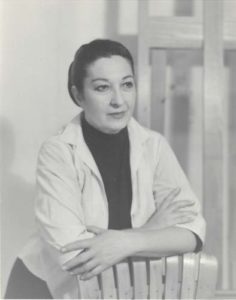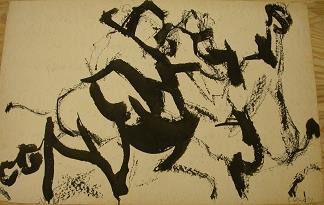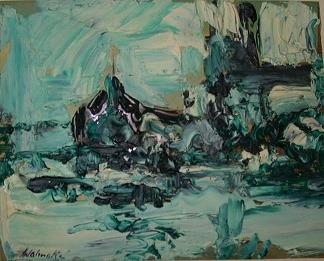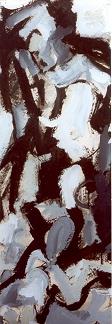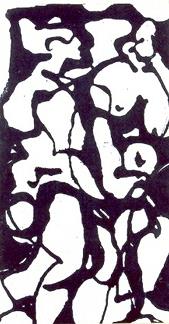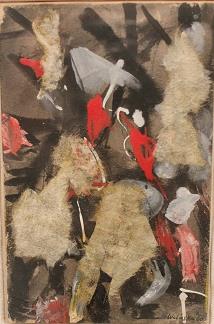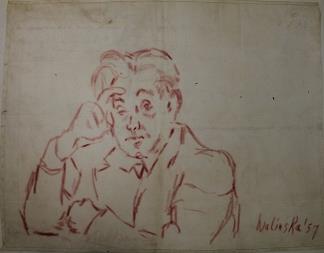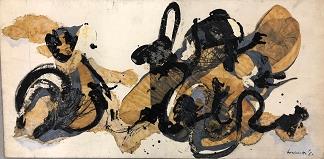The Master Gallery
October 24, 2019 – January 25, 2020

Anna Walinska, Return to the Riverside
Many wonderful childhood memories were made in this building with the woman I called Auntie Anna. My sister and I sat on the floor of her studio while she painted us, caught a glimpse of the innovative works she was creating with spray paint from a can, got to play grown-up at exhibition openings with the likes of the soon-to-be iconic Louise Nevelson, and occasionally peeked in on the classes she taught at the Master Institute.
When my favorite aunt died almost 22 years ago, I became the shepherd of her legacy. Repeatedly hearing that it is nearly impossible to re-emerge an artist who had stopped exhibiting, especially if that artist was a woman, I was determined to tell her story and find a new audience for her work.
It is fitting that her paintings return to The Master, the former home of The Riverside Museum, 40 years after her last lifetime retrospective at the Cathedral of St. John the Divine. Anna Walinska’s work was shown at The Riverside Museum in at least 16 exhibitions between 1954 and 1971, when the Museum closed and the permanent collection, which included one of her paintings, moved to the Rose Art Museum at Brandeis University. Artists with whom she exhibited here included Nevelson, Milton Avery, Jasper Johns, Barnett Newman, Alice Neel, Ethel Schwabacher and Sari Dienes.
Most of the works in this exhibition were created in this building, with the exception of the early self-portrait done in Paris circa 1927 and the small, colorful palette knife paintings which were a product of her trip around the world right before she took up residence at The Master. Paintings made here have appeared in Walinska’s 1957 solo retrospective at The Jewish Museum, the Bodley Gallery, the Museum of Modern Art, the Cathedral of St. John the Divine, the Baltimore Museum of Art, Le Chateau de la Napoule in France, and posthumously at the Muzeum Ghetta, the Theresienstadt Memorial in the Czech Republic, and also belong to numerous private and public collections, including The Jewish Museum, the Denver Art Museum, and Yad Vashem.
If she were with us today, Anna Walinska would have many stories to tell, some of which can be found in her diaries in the collection of the Smithsonian Archives of American Art. One thought she often shared, “As an artist, my medium is visual, not verbal. I express myself with paint, ink and charcoal on canvas and paper, not with words. My work must speak for itself. I hope it will speak to you.”
Rosina Rubin
October, 2019
Anna Walinska Bio (click circle on right to open/close)
Anna Walinskaʼs life and art spans the century of American modernism, paralleling the history of the New York school and the American Jewish experience. Known for her exhilarating joie de vivre, the irrepressible adventuress was born in London in 1906, moved to New York with her family in 1914, and by 1918 (at the young age of 12) had begun her education at the Art Students League.
A woman ahead of her time, Walinska journeyed around the world from 1954-55 and maintained a diary of her travels which is now in the collection of the Smithsonian Archives of American Art. Walinska created thousands of works on canvas and paper over nine decades, with significant influences coming from her extended stays in Paris and Burma. Her body of work also includes several hundred works on the theme of the Holocaust and a series inspired by the 17th century Japanese erotic Shunga prints, which she began at the age of 76.
During her lifetime, Walinska’s work was exhibited in the U.S. and abroad, at venues including the Jewish Museum, the Museum of Modern Art, the Metropolitan Museum of Art, the Baltimore Museum of Art, the Pennsylvania Academy of Arts, the Salon des Independents in Paris, the Marie Harriman Gallery in NYC, and in numerous exhibitions with the American Artists Congress, the Federation of Modern Painters & Sculptors, and the National Association of Women Artists.
Since her death in 1997, her work has been showcased in a number of solo and group exhibitions in the U.S. and abroad.
Her work, Walinska wrote, “sought to convey the spirit of a search without boundaries.”
Figures in Landscape: Woman on Horseback, 1957
ink on paper 23 1/2 x 36 in. lower right Sunken Meadow 1959 AW-I-0603
Figures in Landscape, 1956 (c.)
charcoal & oil on paper 12 x 17 3/4 in. lower left study for painting in collection of Denver Art Museum AW-CHO-1826
Figures in Landscape: The Lake, 1955 (c.)
oil with palette knife on paper 8 1/4 x 9 inches unsigned AW-PK-1349
Survivors (H-30), 1953-56
oil & casein on paper 44 x 29 in. lower right Framed Cathedral St. John 1979 AW-O-0276
Cain & Abel, 1956
casein on paper 44 3/4 x 20 3/4 in. lower right framed: 51 x 27 Bodely Gallery 1956, Jewish Museum Retrospecrive 1957, Baltimore Musem of Art 1959, Cathedral St. John the Divivne 1977 AW-CAS-0496
Sacrifice of Isaac #1, 1953-55
ink on paper 44 3/4 x 20 3/4 in. lower right Framed Jewish Museum Retrospective 1957, Cathedral St. John 1977, Interfaith Center 2000 AW-I-0498
Louise Nevelson study #1, 1963 (c.)
charcoal on board 8 x 5 in. initials lower left framed Study for works in collection of National Museum of Women in the Arts AW-CH-0549
Portrait of Emily: Girl Reading, 1961
casein on board 43 1/2 x 28 in. lower right Framed 49-1/4 x 34-1/8 Jewish Museum retrospective 1957 AW-CAS-0306
Victims: Two Women (H-75), 1960
ink on canvas 14 1/2 x 8 in. Framed Cathedral St. John the Divine 1979, Center for Holocaust Studies/Clark, 2000, Muzeum Ghetta Therezin Czech Republic 2000 AW-I-0286
Exodus: The Homecoming, 1959
oil & Shan paper collage 33 1/4 x 24 in. lower right Framed EXHIBITED RIVERSIDE MUSEUM, 1960, “Japan-American Women Artists Exchange Exhibition in Commemoration of the Centennial of Japan-U.S. Amity Treaty,” in conjunction with the National Association of Women Artists and the Japan Women Artists Institute. AW-COS-1965
Study of a Nude, 1959
spray paint on paper 28 1/4 x 41 1/4 in. lower left Framed Pen+Brush 2017 AW-O-0562


